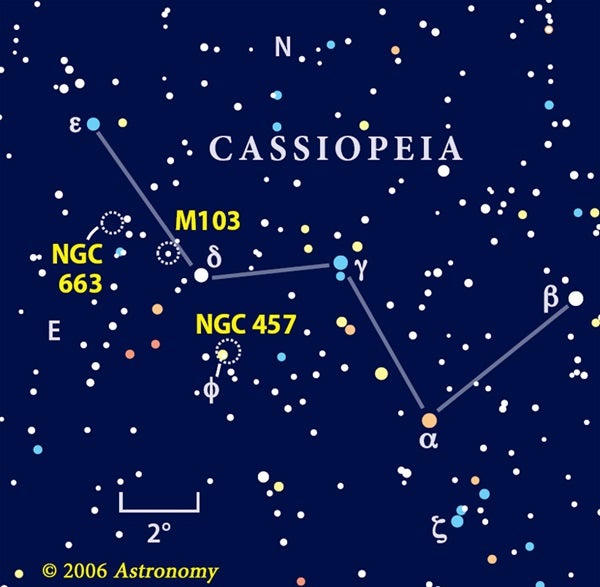One of Cassiopeia’s sights Serviss mentioned lies near the star Zeta (ζ) Cassiopeiae. You’ll find Zeta just south of Schedar (Alpha [α] Cassiopeiae), which marks the lower-right corner of the Queen’s “W” pattern. Through binoculars, 4th-magnitude Zeta’s distinct aquamarine hue contrasts nicely against Schedar’s orangish tint.
Zeta lies at the end of a semicircular asterism of seven fainter stars that Serviss described as an “array of stars … in a broken half-circle, which may suggest the notion of a crown.” Together, they resemble a backward 3 or a miniature Corona Borealis. Because older depictions of the constellation show Zeta representing the Queen’s head, “Cassiopeia’s crown” seems an appropriate name for this little asterism.
Let’s go deeper into the constellation by following the zigzag path along the Cassiopeia five-star “W” to Ruchbah (Delta [δ] Cassiopeiae), at its lower-left corner. Aim half a binocular field to the southwest of Ruchbah toward 5th-magnitude Phi (φ) Cassiopeiae. You’ll see a second fainter star just to Phi’s southwest as well as a tiny smear of dim starlight to the north. Together, they form the Owl Cluster, NGC 457. The two brightest stars mark the owl’s eyes, while the fainter suns outline its body and outstretched wings. Some observers imagine a dragonfly here, while others see the movie character ET. Although most binoculars reveal the cluster, you’ll probably need at least 15x to see any hint of these heavenly creatures.
Most studies indicate Phi doesn’t actually belong to NGC 457, but, instead, just happens to fall along the same line of sight. Strangely enough, Phi appears to move through space in the same direction as the cluster. This usually indicates a physical association. If that’s so, then at the cluster’s distance of 9,000 light-years, Phi would have to be an incredible 250,000 times more luminous than our Sun.
Next, let’s stop by open cluster M103, located to the other side of Ruchbah. My 10x50s show this group as a small triangular patch of starlight nestled in a pretty Milky Way field. I can make out four or five separate stars here. The rest of its 170 members pool their faint light to create what looks like a tiny arrowhead. Others think M103 resembles a handheld fan.
Scan the area around M103, and you will notice the hazy glow of NGC 663 a little east of the halfway point between Ruchbah and the star Segin (Epsilon [ε] Cassiopeiae). In fact, you may see it before you even notice M103. NGC 663 looks like an unresolved blur of light through my 10x50s, while my 16x70s add a few feeble points of light.
Astronomy magazine podcast: Touring Cassiopeia











